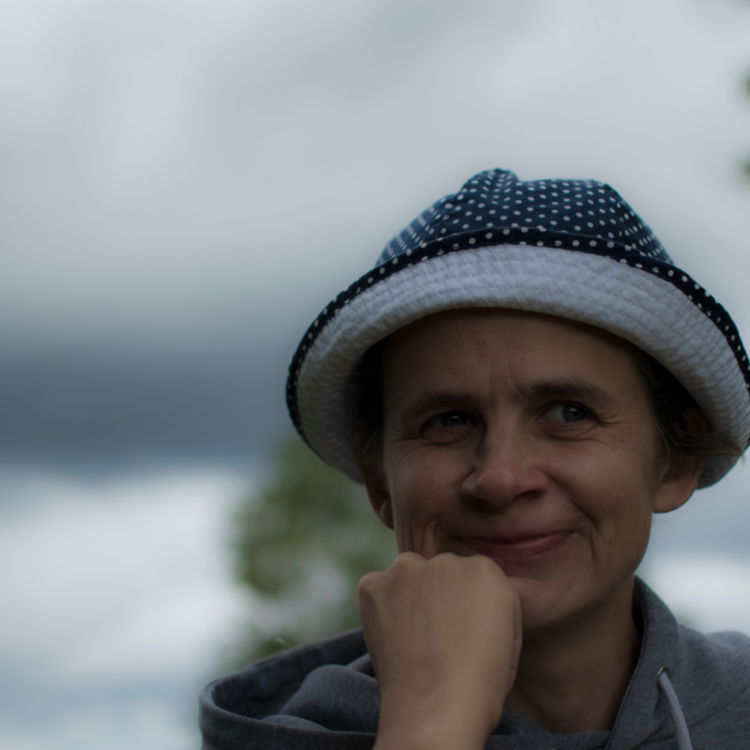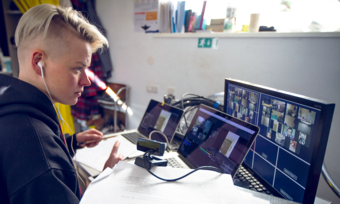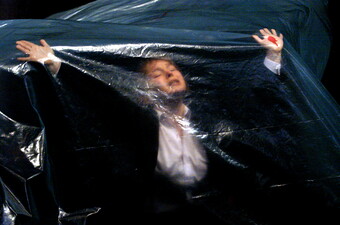Roads into Portrayals of Mental Health Onstage
I had been invited to observe Belarus Free Theatre’s (BFT) workshop exploring A Road Back from Schizophrenia, a controversial 2012 memoir by Norwegian Arnhild Lauveng chronicling her painful recovery from schizophrenia, in preparation for Tomorrow I Was Always A Lion, their new show based on Lauveng’s account. The idea was to gather medical professionals and artists who live with hearing voices (HV) or seeing visions (SV), to work together with BFT to consider director Vladimir Shcherban’s three questions about the work in relation to its adaptation to stage: “What is schizophrenia? Where is the line between the illness and a patient’s rights? What methods can we find to tell this private story in a simple way?”
In the room were postdoctoral researchers in psychological medicine, psychiatrists, project managers for youth and community theatre projects, artists, and project leaders/consultants, as well as actors and BFT’s creatives. They were to proceed through the day with a series of activities and discussion exercises, these were: participant presentations, spectogram (a true or false statement exercise), mapping of power (or mapping Lauveng’s world), actor investigations (questions from the actors to the scientists), and a final group discussion.
There has long been a struggle in the UK to break down perceived barriers between the art, science, and medical worlds, and because A Road Back from Schizophrenia is considered to be controversial as it challenges medical notions about the debilitating illness, I was curious to see how and where the doctors and medical professionals and artists would meet in their findings based upon the text and how they might collaborate together.
At the Intersection of the Subject of Mental Illness on Stage
In 1959, the English chemist and novelist C. P. Snow, delivered the Cambridge lecture "Two Cultures," where he inferred that art could sometimes “make one complacent in one’s tragedy” and that artists and scientists regarded each other through levels of distortion. It seems that in the Western world and in the UK in particular, the two disciplines have come closer together.
Nearer to present day, in 2013 the Barbican ran a season of performances and debate on art and neuroscience, works like Lucy Prebble’s The Effect invited audiences to consider the nature of love, depression, and neuroscience and neuroscientists are increasingly turning to the works of Samuel Beckett to better understand our emotions and thought patterns. There is a conscious attempt in both worlds to open up the disciplines to the potentials of each other: art can take inspiration from scientific and medical discoveries whilst science and medicine needs the imaginative flair of the arts.
In the world of mental health today, groundbreaking plays such as Joe Penhall’s Blue/Orange, challenging institutional and cultural prejudices towards black, working class young men with mental health problems, has imploded such attitudes by opening them up to debate. So too has work like 4.48 Psychosis by Sarah Kane (4.48 was BFT’s inaugural production and a work Shcherban knows well and which he referenced repeatedly during the day), which breaks down boundaries where there may be tendencies to unconsciously identify women by their psychosis, by liberating character(s) from the so-called Sylvia Plath syndrome.
The Workshop
Shcherban’s first question to the group was: “What is schizophrenia?” Dr. Cathy Wainhouse, a participant and clinical psychiatrist specializing in young people's psychiatry, made the point that the criteria for assessing whether a person is schizophrenic is always changing (every ten or eleven years). She also made the point that Lauveng’s writing style was so coherent and clear, it was difficult to believe that she had had schizophrenia and it was perhaps more likely that she had been misdiagnosed. This point about the clarity of Lauvent’s prose raised an interesting conundrum for the group and BFT: can writing style falsify experience if it serves to contradict or overarticulate diagnosis? It is obvious that the book articulates the schizophrenia in a precise and clinical way by clearly presenting the different voices Lauveng heard (the voice of The Captain, for example) and the disparate realities going on in Lauveng’s head. Lauveng’s account comes from a position of stability post illness. But though Dr. Wainhouse asserted that Lauveng’s writing is perhaps “theatrical,” she is not writing for dramatic effect. Her story also ends relatively happily, whereas it is often considered, though by no means proved, that 4.48 Psychosis is Kane’s suicide note.
But were Shcherban and his ensemble interested in such provocations over diagnosis or questions over the nature and detail of the author’s recollections and therefore style of writing? His and the actors’ positions seemed much more ambivalent and more interested in the human element than the medical one. For example, Shcherban asked Rai Waddingham, project lead of Voice Collective and someone who also hears voices, what is holding her back from doing what the voices tell her. She insisted it was because she has a choice and that she now listens to them in order to understand what she is feeling. For Shcherban this fed into his thematic concern about how a person can accept and live with oneself (in spite of society’s “labels”).
The need for the group to understand Lauveng’s story was exemplified by the physical mapping exercise, in which the many elements of Lauveng’s world were physically personified and moved around in relationship to each other like pieces on a chessboard. For example, how physically close should Lauveng’s family be positioned to the author onstage? Should the Forest (a metaphor in the book and represented by myself) be physically overwhelming the writer or should counselors be positioned between her and it? How close onstage should The Captain get to Lauveng? Did the excercise help illuminate Shcherban’s original question about schizophrenia? It quickly became clear that once mapped out, schizophrenia and all the trappings that go with it can mean much more than the diagnosis and that in Lauveng’s use of imagery (the Forest for example, also perceived as sexual) the beginnings of a hidden self could be found. When this led someone to ask how useful a diagnosis really is, it then seemed apt for Dolly Sen (an artist who hears voices) to comment that a diagnosis can “define a person’s story, rather than they themselves.” (In a sense, during the many queries around Lauveng’s diagnosis, this is exactly what was happening in the workshop. She was being defined by it and the diagnosis seemed a limitation rather than merely one element of her.)
Breaking Taboos
During the course of the workshop it became obvious that the position of ambivalence seemingly adopted by the artists towards an exact mental illness diagnosis was in slight contradiction to some of the practicing psychiatrists in the room who base their methods on first prevention (in young children) and/or containment. Shcherban’s second question, about the lines between the illness and a person’s rights, also highlighted opposing opinions. The group was asked about the usefulness of taboos and whether, for example, self-harm should still be considered to be one. Some academics and doctors believed that taboos can be useful to prevent such harmful behaviors. Others, including Sen and Waddingham, maintained that taboos can hide and oppress such desires and make them worse.
The contradicting attitudes towards schizophrenia and what it actually is, what is taboo and whether taboos are useful, might have been an illustration of the divided attitudes within the group.…Stories heal and what story is not theatrical, exaggerated, and in some way metaphorical?
But theatrical art is all about taboo busting and the biggest taboo of all, the one Shcherban was waiting for someone to bring up, was left in the closet. Shcherban put it to the group that no one was talking about what may have happened to Lauveng’s sexuality during her years shut away in an institution when she was an adolescent. Whilst there was a comment from the doctors that medication would always suppress a person’s sex drive, both Sen and Waddingham made the point that if a patient was gay, or their sexuality was different to the “perceived norm” in some way, this was often pathologized by medical teams. Later I asked Shcherban why no one was talking about sex and mental illness, not even the artists who themselves HV and SV and he suggested that society still cannot understand mentally ill people as rounded human beings, with the same needs as everyone else.
The contradicting attitudes towards schizophrenia and what it actually is, what is taboo and whether taboos are useful, might have been an illustration of the divided attitudes within the group, but they also provided an integral critical atmosphere, where other notions could be examined. For example, Dr. Wainhouse’s early assertion that everything Lauveng wrote was theatrical, whilst being true, is also the point, as illustrated by the workshop. Stories heal and what story is not theatrical, exaggerated, and in some way metaphorical? And the last question, about how such a private work could successfully be transferred to stage seemed to beg another: how much do the stories we concoct in our heads and role playing permeate real life? Jim Pope, a mental health project partner of the Albany Theatre commented that kids in drama exercises at Maudsley NHS Foundation Hospital would hang their psychoses up at the door and engage in role playing drama games, only to put their psychoses back on again in order to reenter into the outside world. Did Lauveng use her diagnosis as a similar kind of coping mechanism? Could this be used as a stylistic device within the play?
Where does the art stop and the condition begin?
Too Well to be Sick?
But what seemed to frustrate Dr. Wainhouse and others more than anything was Lauveng’s ability to recollect her schizophrenic experiences so distinctly and be so clear in her written explanation of them. Yet the day’s exercises seemed to illustrate that Lauveng’s authorial voice is also role play. When the actors performed a short reading for the group, Lauveng’s voice was authoritative and unreal. The Captain’s voice, however, was more human. In art there is no one objective stance from which we can look at reality, no matter how much science and the medical world will there to be one. Here, in their rough interpretation, Shcherban and the ensemble seemed to be using The Captain as the way into Lauveng, perhaps asking us to look at her through him, although he is a concoction of Lauveng’s. It was interesting to note how the doctors and researchers, were looking at Lauveng through her authorial voice. Dominic Campbell, project manager for Meet Me at the Albany, Albany Theatre asked, “When can a person identify with self and the larger society and intervene to bring both together” (presumably within artistic frameworks)? But later Shcherban asserted “Art is not about answers, but about guesses.” He further added, “Where does the art stop and the condition begin? You can argue whether Lauveng had schizophrenia or not. But it is important to understand her experience and how art is therapy.” Dr. Helen Fisher, lecturer at the MRC Centre for Social, Genetic and Developmental Psychiatry at King’s College, London, answered, “Where is the line? Lauveng wants to kill herself, but doesn’t do it.” This raises the question, when does art stop being a salvation? This seemed a critical question to ask because what it really means is, how might Lauveng’s story be interpreted for stage in a way that is safe?
At the end of the workshop it was clear the day raised some provocative challenges. First of all, did Lauveng actually have schizophrenia or was she living under a misdiagnosis? How much of the discussion will be important to the finished play and of concern to the artists as much as it became a concern to the doctors at the workshop? Therefore, where does the artist’s responsibility lie? Can the artist find a way of combining artistic integrity with scientific and medical truth? Is there a way in which Lauveng’s diagnosis can be challenged without discrediting her experiences? What happened to Lauveng’s sexuality during the course of her treatment? Sen insisted that this was important as sexuality is directly related to a person’s notion of personal boundaries. How much can art heal? As Lauveng’s book suggests that she found a way toward a “cure” for herself, Dr. Wainhouse highlighted the very real danger that audiences may come to the show expecting to learn about one. In response to her concerns, Shcherban invited her to appear in the show as a critical voice.
Perhaps Dr. Wainhouse and others with a more questioning approach towards Lauveng’s work might agree to appear in the show. If they do, or their voices are given stage time, this seems at least to be precisely where art and science and medical worlds can meet, each holding up their own hypotheses for the other to question and doubt.
Tomorrow I Was Always a Lion will be presented by Belarus Free Theatre at Arcola Theatre, October 19–29 and at The Albany, November 1-12, and will livestream on HowlRound TV Saturday, October 22 at 7:30pm BST (London) / 2:30pm EDT (New York) / 18:30 UTC.






Comments
The article is just the start of the conversation—we want to know what you think about this subject, too! HowlRound is a space for knowledge-sharing, and we welcome spirited, thoughtful, and on-topic dialogue. Find our full comments policy here
I think it’s a good idea to have a show based on mental illness, it’s a great way for people to see what it’s like to live with a mental illness. I especially loved the part in the essay when the artists said they felt their diagnosis was defining them and limiting them, rather than themselves the humans being defined. You could do a whole different show about how people can not let their mental illness define them. It is interesting that Lauveng’s writing was clear and the doctor thinks she was misdiagnosed. I think a better understanding of Lauveng’s diagnosis will help the process.